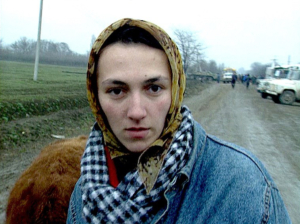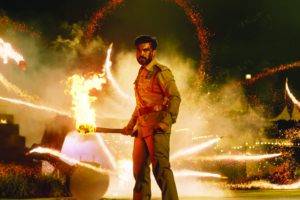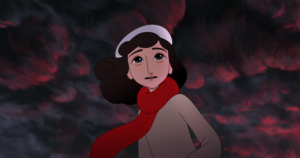A man stands before three witches; a glinting dagger floats in a castle hallway; a grisly, ghostly figure sits silently at a banquet. These uncanny images have become some of the most famous in English literature, standing in for themes of unchecked ambition, self-fulfilling prophecy and corrupting power. One of William Shakespeare’s most celebrated plays, Macbeth has been studied for hundreds of years, staged countless times and adapted into over twenty feature films, including by such distinctive filmmakers as Orson Welles and Roman Polanski. How, then, might a director today transform this familiar, beloved story into something new and surprising? With his 2021 adaptation, The Tragedy of Macbeth, Joel Coen offers a film that is, in its own way, uncanny – at once strange and familiar.
The Tragedy of Macbeth is Coen’s solo feature directorial debut,[1]Although solely credited for his first nine features due to Directors Guild of America rules, Coen shared directorial duties on all those productions with his brother Ethan. a film that differs substantially from previous adaptations of Macbeth and indeed from much of the filmmaker’s previous work. Working as a fraternal writing and directing duo for over three decades, Joel and Ethan Coen are two of the most recognisable and commercially successful names in independent filmmaking, and their extensive filmography is notable for its diversity of genre and filmic style. As film scholar Jeffrey Adams writes, little in the way of an identifiable ‘stylistic “signature”’ can be detected across their oeuvre, with the brothers preferring instead to ‘work in impersonal generic forms, changing styles with each new film’.[2]Jeffrey Adams, The Cinema of the Coen Brothers: Hard–boiled Entertainments, Columbia University Press, New York, 2015, p. 2. That said, many have noted certain consistencies within the Coens’ work: for instance, deftly crafted original screenplays with particular attention paid to dialogue; and what Adams terms ‘hermeneutic treasure hunting’, or an intentional ambiguity of meaning and message that tempts the viewer to ‘decipher what appears to be a hidden code’ within the films.[3]ibid., p. 3.
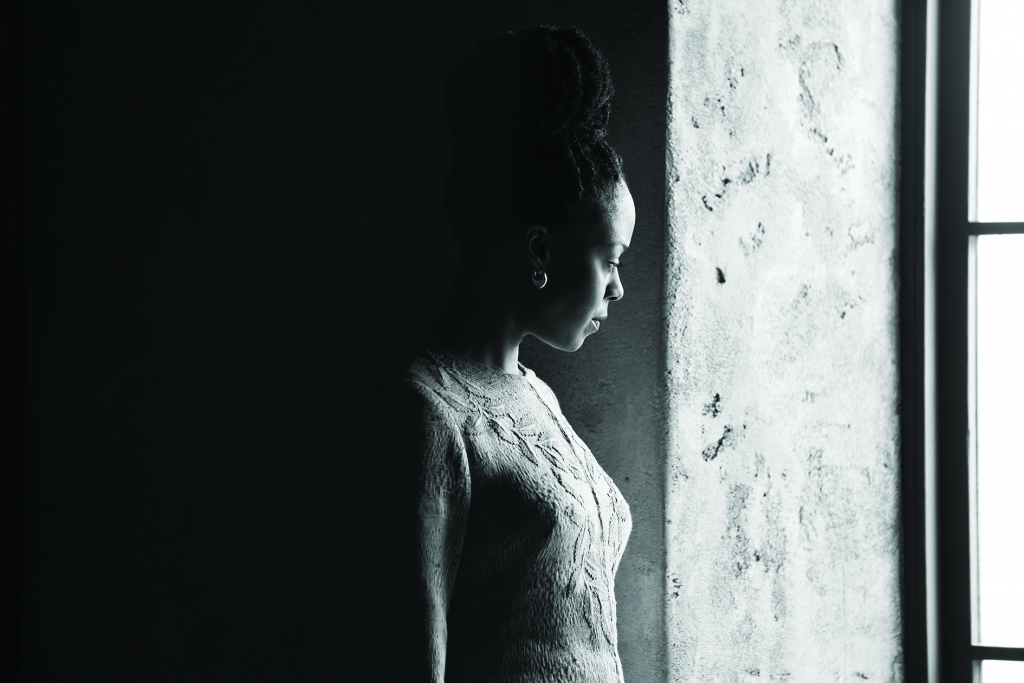
Joel Coen’s turn to one of the most well-known, deeply studied texts in the English language is therefore an interesting development in the filmmaker’s career. The idea for the film reportedly came from his wife, actor Frances McDormand, who was interested in starring in a theatrical staging of the play directed by her husband; the project eventually became a feature film.[4]Jake Coyle, ‘Joel Coen Distills Macbeth Down to the Bone’, Associated Press News, 23 December 2021, <https://apnews.com/article/entertainment-arts-and-entertainment-movies-oscar-isaac-joel-coen-926464971330ffcf8c73c188e7ae7e26>, accessed 8 January 2022. Yet Coen had a specific vision for what his adaptation would look like – or, rather, what it wouldn’t look like. As he has recounted in interview, ‘From the beginning, we weren’t interested in doing a realistic version of the play. We weren’t interested in a rent-a-castle version.’[5]Joel Coen, quoted in Coyle, ibid.
Coen’s staunch rejection of realism differs from another recent feature version of the play, Australian director Justin Kurzel’s Macbeth (2015), which took a gritty, large-scale approach to the text. This vision of eleventh-century Scotland is of an expansive, mountainous land of earthy greens and deep blues, home to epic battle scenes shot on location with hundreds of extras. Kurzel moves the camera quickly through the blood and dirt of combat, lingering in disturbing slow motion on soldiers’ pained, twisted faces as knives are thrust into bodies and throats are cut.

The Tragedy of Macbeth, in contrast, is a minimalistic interpretation of the play that disturbs in a different way. Coen’s film is shot in crisp black-and-white, alternately emphasising harsh shadows and blinding whites. It is also presented in Academy ratio – most common to movies made from the 1930s through to the early 1950s – which encloses the image in an unusually narrow, nearly square frame. But what is perhaps most striking about the film is its production design. Produced on a sound stage in Los Angeles, The Tragedy of Macbeth blends the cinematic with the theatrical, conferring a certain two-dimensional quality to the stripped-back sets, as if the drama were indeed taking place on a stage. Macbeth (Denzel Washington) first comes across the witches as he walks across an almost wholly white void; King Duncan’s (Brendan Gleeson) tent is apparently set up in the middle of nowhere; Macbeth’s castle is a sparse, brutalist construction with harsh shadows, large columns and barely any furniture or embellishments. Even outdoor scenes have a feeling of interiority: the sky is a heavy blanket of unnaturally dense stars bearing down from above; distant oceanside cliffs appear as a static, almost painted backdrop for the human drama in the foreground. Through this careful, unusual production design, Coen brings attention to the artifice of the production, problematising fiction cinema’s traditional goal of verisimilitude.
This theatre-inspired production design positions the events of the film within an uneasy, liminal space somewhere between the real world and the false, a space that complements the unnatural horrors of Shakespeare’s play.
This theatre-inspired production design positions the events of the film within an uneasy, liminal space somewhere between the real world and the false, a space that complements the unnatural horrors of Shakespeare’s play. Within this world, Coen presents a series of stark, unsettling images, many of which could be described as uncanny. In his 1919 essay of the same name, Sigmund Freud described the uncanny as ‘all that is terrible […] all that arouses dread and creeping horror’.[6]Sigmund Freud, ‘The “Uncanny”’, in Freud, Studies in Parapsychology, trans. Philip Rieff, Collier Books, New York, 1963 [1919], p. 19. Yet the uncanny is more than just frightening images; it is, Freud suggests, specifically ‘that class of the terrifying which leads back to something long known to us, once very familiar’.[7]ibid., p. 20. Directors of Gothic or horror films often utilise the uncanny to create a sense of dread or discomfort within the viewer, frequently through images including – as identified by art historian Jamie Ruers, paraphrasing Freud – ‘doubles, ghosts, mirrors, the home and its secrets, madness and severed limbs’.[8]Jamie Ruers, ‘The Uncanny’, Freud Museum London blog, 18 September 2019, <https://www.freud.org.uk/2019/09/18/the-uncanny/>, accessed 8 January 2022.

There are several such uncanny images in The Tragedy of Macbeth. The film’s opening scene features one of the witches (Kathryn Hunter) delivering the opening monologue while sitting in an unnaturally contorted position, the camera staying uncomfortably close as she recites lines through twisted limbs: ‘Fair is foul and foul is fair: Hover through the fog and filthy air.’ When Macbeth comes across the witches for the first time, one of them stands on the other side of a small pool, but two dark figures are reflected on the water below, a stunning and unsettling image. Later, the witches appear in Macbeth’s castle – perched high on the rafters like birds as they drop disgusting ingredients into a vast potion below – but it is unclear if this is real, or merely dreamt by the watching Macbeth (is there a difference?). The three witches are one of the most iconic aspects of Shakespeare’s play, yet The Tragedy of Macbeth only shows one of the women in full; the faces of the others, when they appear, are kept concealed. Is there one witch or three? Are they human or animal, or somewhere in between? Coen’s adaptation hinges on such epistemological uncertainties, creating a world that is itself, like the uncanny, unsettling yet recognisable.
Indeed, within this strange in-between world, Coen remains largely faithful to the original story and script of Shakespeare’s play. Macbeth, an officer in the Scottish army, is told by three ‘weird sisters’ that he will one day be king himself, igniting within him – and perhaps even more so within his wife – a fiery sense of ambition that sets into motion a violent series of events that inevitably lead to his downfall. The narrow aspect ratio and interiority of the sets offer a fitting sense of claustrophobia to Coen’s adaptation, reflecting the consequences of Macbeth’s actions closing in on him. His castle is representative of his psyche; his initial, isolating regret; and his growing paranoia: echoey and empty, it has deep, sweeping shadows that might conceal silent watchers, and large columns to conceal secret listeners. The black-and-white photography makes it difficult to determine at any time whether it is night or day. The castle defies easy navigation: long hallways lead nowhere; square courtyards stand empty; wings of the castle are full of empty rooms.

The maze-like design of Macbeth’s castle is an example of the uncanniness of ‘the home and its secrets’. It disorients both the viewer and Macbeth himself, enveloping him wholly until he has little regard for the outside world. Indeed, while Kurzel’s Macbeth shows the broad, fertile lands of Scotland, Coen’s film shows little of the lands or the people over whom Washington’s Macbeth so desperately wants to rule. It is striking not merely that Macbeth wishes to become king at all costs, but that he wishes to become king of this sparse, nightmarish nothingness.
In The Tragedy of Macbeth, Coen offers a unique and striking reinterpretation of Shakespeare’s play, one that would certainly be of interest and help to those studying the playwright for the first time.
Coen makes other interesting directorial choices, including reworking the standard five-act structure of Shakespearean drama. Coen divides the film roughly in two, with each half preceded by an intertitle featuring a large, single word from one of the play’s most famous passages. The film opens, for example, with the word ‘when’, towering in white Gothic letters over a black background, taken from the opening line: ‘When shall we three meet again / In thunder, lightning or in rain?’ This question, when, haunts The Tragedy of Macbeth as an undercurrent running beneath the drama. There is a heightened sense of impatience throughout, one of time running out, further highlighted by the casting of Washington in the titular role and McDormand as Lady Macbeth.

Previous film adaptations have tended to figure Macbeth as a relatively young man: Welles was thirty-two when he starred in his own adaptation; Jon Finch was only twenty-nine in Polanski’s; and Michael Fassbender was thirty-seven when Kurzel’s version was shot. Washington, by contrast, is sixty-seven, and the casting of an older actor subtly transforms the meaning of the original play in interesting ways. His close-cropped, greying hair stands out within the black-and-white photography, as do McDormand’s long, silvery locks. Washington gives a fantastic performance: his monologues soar in moments of commanding power and ambition, then dip into periods of vulnerability. His Macbeth is not a rising young figure in the army, but rather a seasoned, capable general who has nevertheless stalled somewhat in the final stages of his life – and who is, therefore, easily seduced into making one last break for glory.
Given this casting, lines from the original play take on greater meaning. In the tumultuous night after Macbeth kills King Duncan in his sleep, he hears a booming sound with no clear source. ‘Whence is that knocking?’ Macbeth bellows. ‘How is’t with me, when every noise appals me?’ As the knocks continue, it’s hard not to hear them as the sinister ticking of a clock counting down the moments left for Macbeth to achieve the greatness he strives for, in time with the fresh dripping of King Duncan’s blood onto the floor. Later, after Macbeth kills Macduff’s wife (Moses Ingram) and child (Ethan Hutchison) to prevent a prophecy from coming to fruition, Macduff (Corey Hawkins) states the difficulty of taking revenge: ‘He has no children.’ In the context of a more mature Macbeth, this is not only a question of vengeance but a question of what the character will leave behind. The Tragedy of Macbeth speaks not only to the play’s classic, broad theme of ambition, but also to specific anxieties related to ageing, mortality and legacy.
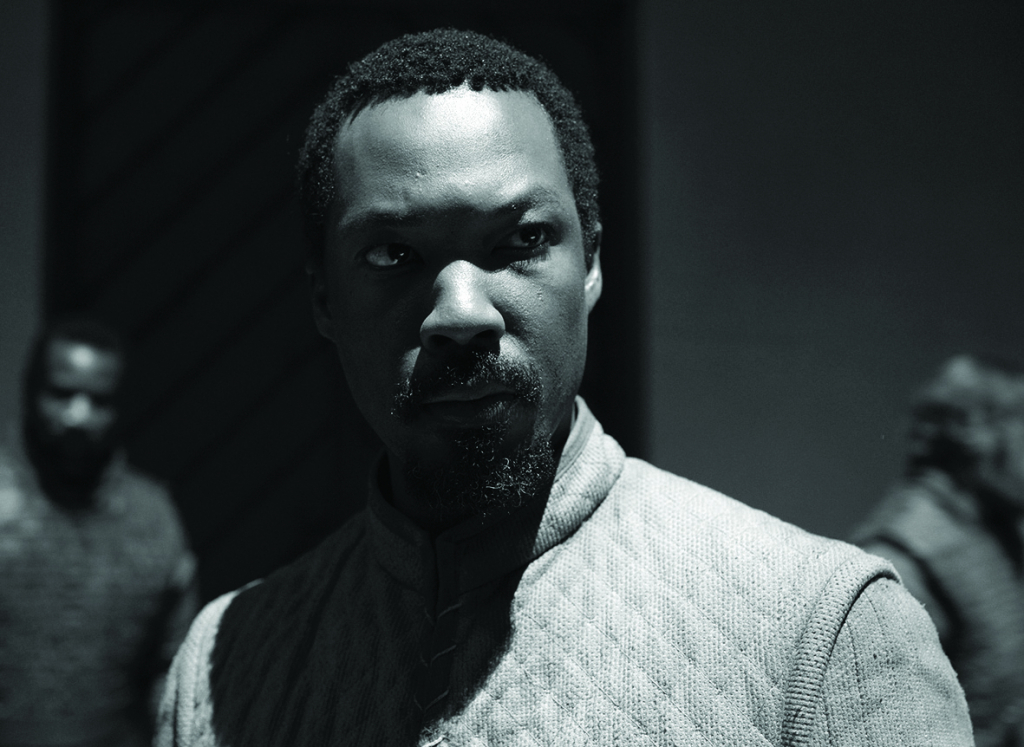
The final part of the film is introduced by the word ‘tomorrow’. This is the unravelling of Macbeth’s plans, the morbid answer to his unspoken question of ‘when’. Carter Burwell’s score, previously subtle and understated, becomes more pronounced, taking on a minor, haunting tone as it leads into the film’s climax. Lady Macbeth transforms from the assured, cunning woman seen before into a ghostly, sleepwalking figure, obsessively washing her hands. Coen uses impressive staging to convey his protagonist’s isolation in his final moments; as Macbeth opens a tower window, a gust of wind pours hundreds of leaves into the room, an inventive visual representation of the witches’ prophecy: ‘Macbeth shall never vanquish’d be until / Great Birnam wood to high Dunsinane hill / Shall come against him.’ Fitting the film’s pared-back tone, the climax does not feature an epic battle between clashing armies, but rather Macbeth and the young Macduff trading sword blows on a narrow rooftop of the castle, until the latter deals the fatal stroke.
In The Tragedy of Macbeth, Coen offers a unique and striking reinterpretation of Shakespeare’s play, one that would certainly be of interest and help to those studying the playwright for the first time. The film dispenses with extraneous scenery, props and sets, focusing more on the dialogue and the performances. Coen takes advantage of the cinematic form – through imaginative scene transitions, unsettling special effects and those great uncanny images mentioned previously – while maintaining fidelity to the play through theatrical-style staging and production design, allowing a new student of Shakespeare to imagine, in many instances, how the play might look on the stage. The film sticks closely to the original story and dialogue, capturing the play’s dark tone, magic realism and perverse supernaturalism that would have enthralled seventeenth-century audiences. Yet it also adds much that is new and surprising: there is a lot of scope for further student research in terms of the uncanny, the film’s cinematographic choices and the place of the film within Coen’s wider oeuvre as one of the most original working filmmakers in the United States. The Tragedy of Macbeth demonstrates the enduring capacity of Shakespeare’s stories to entertain audiences – but perhaps even more so, the role of the modern director in turning those stories into something new.
Endnotes
| 1 | Although solely credited for his first nine features due to Directors Guild of America rules, Coen shared directorial duties on all those productions with his brother Ethan. |
|---|---|
| 2 | Jeffrey Adams, The Cinema of the Coen Brothers: Hard–boiled Entertainments, Columbia University Press, New York, 2015, p. 2. |
| 3 | ibid., p. 3. |
| 4 | Jake Coyle, ‘Joel Coen Distills Macbeth Down to the Bone’, Associated Press News, 23 December 2021, <https://apnews.com/article/entertainment-arts-and-entertainment-movies-oscar-isaac-joel-coen-926464971330ffcf8c73c188e7ae7e26>, accessed 8 January 2022. |
| 5 | Joel Coen, quoted in Coyle, ibid. |
| 6 | Sigmund Freud, ‘The “Uncanny”’, in Freud, Studies in Parapsychology, trans. Philip Rieff, Collier Books, New York, 1963 [1919], p. 19. |
| 7 | ibid., p. 20. |
| 8 | Jamie Ruers, ‘The Uncanny’, Freud Museum London blog, 18 September 2019, <https://www.freud.org.uk/2019/09/18/the-uncanny/>, accessed 8 January 2022. |


